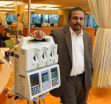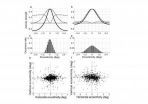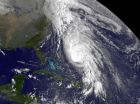(Press-News.org) BUFFALO, N.Y. -- A study by the University at Buffalo shows for the first time that obese males ages 14 to 20 have up to 50 percent less total testosterone than do normal males of the same age, significantly increasing their potential to be impotent and infertile as adults.
The paper was published online as an accepted article in Clinical Endocrinology.
The authors are the same researchers in the University at Buffalo's School of Medicine and Biomedical Sciences who first reported in 2004 the presence of low testosterone levels, known as hypogonadism, in obese, type 2 diabetic adult males and confirmed it in 2010 in more than 2,000 obese men, both diabetic and nondiabetic.
"We were surprised to observe a 50 percent reduction in testosterone in this pediatric study because these obese males were young and were not diabetic," says Paresh Dandona, MD, PhD, SUNY Distinguished Professor in the Department of Medicine, chief of the Division of Endocrinology, Diabetes and Metabolism in the UB medical school and first author on the study. "The implications of our findings are, frankly, horrendous because these boys are potentially impotent and infertile," says Dandona. "The message is a grim one with massive epidemiological implications."
The small study included 25 obese and 25 lean males and was controlled for age and level of sexual maturity. Concentrations of total and free testosterone and estradiol, an estrogen hormone, were measured in morning fasting blood samples. The results need to be confirmed with a larger number of subjects, Dandona says.
"These findings demonstrate that the effect of obesity is powerful, even in the young, and that lifestyle and nutritional intake starting in childhood have major repercussions throughout all stages of life," he says.
In addition to the reproductive consequences, the absence or low levels of testosterone that were found also will increase the tendency toward abdominal fat and reduced muscle, Dandona says, leading to insulin resistance, which contributes to diabetes.
"The good news is that we know that testosterone levels do return to normal in obese adult males who undergo gastric bypass surgery," says Dandona. "It's possible that levels also will return to normal through weight loss as a result of lifestyle change, although this needs to be confirmed by larger studies."
The UB researchers now intend to study whether or not weight loss accomplished either through lifestyle changes or through pharmacological intervention will restore testosterone levels in obese teen males.
INFORMATION:
A photo of Dandona is at http://www.buffalo.edu/news/13736.
Co-authors with Dandona are Muniza Mogri, MD, a medical resident in the UB Department of Pediatrics, Sandeep Dhindsa, MD, clinical assistant professor of medicine at UB; Husam Ghanim, PhD, research assistant professor of medicine; and Teresa Quattrin, MD, A. Conger Goodyear Professor and chair of the Department of Pediatrics, housed in Women and Children's Hospital of Buffalo.
Obese teen boys have up to 50 percent less testosterone than lean boys, UB study finds
Results send 'grim message' that obese teen males may become impotent, infertile adults
2012-10-17
ELSE PRESS RELEASES FROM THIS DATE:
Common birth control device may be cost-effective treatment for early endometrial cancer
2012-10-17
AUGUSTA, Ga. – A common birth control device is effective in treating early-stage endometrial cancer in morbidly obese and high-risk surgery patients, said Georgia Health Sciences University Cancer Center researchers, and could lead to a cost-effective treatment for all women with this cancer type.
Endometrial cancer, which starts in the lining of the uterus, is the third most common gynecologic cancer, striking more than 47,000 American women every year, particularly the obese. "Total hysterectomy, sometimes with removal of lymph nodes, is the most common treatment ...
Abnormal involuntary eye movements in amblyopia linked to changes in subcortical regions of brain
2012-10-17
Amsterdam, NL, October 16, 2012 – Little is known about oculomotor function in amblyopia, or "lazy eye," despite the special role of eye movements in vision. A group of scientists has discovered that abnormal visual processing and circuitry in the brain have an impact on fixational saccades (FSs), involuntary eye movements that occur during fixation and are important for the maintenance of vision. The results, which raise the question of whether the alterations in FS are the cause or the effect of amblyopia and have implications for amblyopia treatment, are available ...
Viral alliances overcoming plant defenses
2012-10-17
PULLMAN, Wash.— Washington State University researchers have found that viruses will join forces to overcome a plant's defenses and cause more severe infections.
"These findings have important implications in our ability to control these viruses", says Hanu Pappu, Sam Smith Distinguished Professor of Plant Virology and chair of WSU's Department of Plant Pathology. "Mixed infections are quite common in the field and now we know that viruses in these mixed infections are helping each other at the genetic level to overcome host defenses and possibly lead to the generation ...
New paper reveals fundamental chemistry of plasma/liquid interactions
2012-10-17
Though not often considered beyond the plasma television, small-scale microplasmas have great utility in a wide variety of applications. Recently, new developments have begun to capitalize on how these microplasmas interact with liquids in applications ranging from killing bacteria for sterilizing a surface to rapidly synthesizing nanoparticles.
An interdisciplinary collaboration between researchers at Case Western Reserve University and the University of Notre Dame has revealed a critical interaction that is occurring at this plasma-liquid interface in that the electrons ...
Immune response may link social rejection to later health outcomes
2012-10-17
No matter which way you look at it, rejection hurts. Experiencing rejection from a boss, a friend, or a partner is difficult enough for many adults to handle. But adolescents, who are dealing with the one-two punch of biological and social change, may be the most vulnerable to its negative effects.
In a new study published in Clinical Psychological Science, a journal of the Association for Psychological Science, researcher Michael Murphy and colleagues examine the human immune response as a potential link between social stressors like rejection and later mental and physical ...
Jelly-like atmospheric particles resist chemical aging
2012-10-17
Cambridge, Mass. - October 16, 2012 - Atmospheric chemists at the Harvard School of Engineering and Applied Sciences (SEAS) have found that when it comes to secondary organic material in the atmosphere, there are two distinct breeds: liquids and jellies.
Secondary organic materials (SOM) are airborne particles that have begun to react with gases in the atmosphere. In the last 20 years' research and climate modeling, these SOM particles have been assumed to drift as liquids. In a liquid phase, the organic materials would absorb other compounds like ammonia or ozone very ...
NASA: How do you solve a problem like (Tropical Storm) Maria?
2012-10-17
The song "How do you solve a problem like Maria?" from the famous film "The Sound of Music" comes to mind when looking at NASA satellite imagery of Tropical Storm Maria churning in the western North Pacific Ocean. The answer lies in increased wind shear and cool ocean temperatures – two factors that can weaken the storm, but won't be present over the next day or two.
NASA's Aqua satellite passed over Tropical Storm Maria on Oct. 16 at 0355 UTC, 12:55 p.m. local time Tokyo/Japan (Oct. 15 at 11:55 p.m. EDT) and the Moderate Resolution Imaging Spectroradiometer (MODIS) instrument ...
NASA sees Hurricane Paul 'eye' Mexico's Socorro Island, coastline
2012-10-17
NASA's Aqua satellite captured a stunning image of Hurricane Paul in the eastern Pacific Ocean that revealed Mexico's Socorro Island was just outside of Paul's eye. Now, Paul is expected to track along the Baja California coast, triggering more warnings.
Hurricane Paul is stirring up rough seas in the eastern Pacific Ocean and warnings are posted along Baja California.
A hurricane warning is in effect for the west coast of Baja California from Santa Fe northward to Punta Abreojos. A tropical storm warning is in effect for the west coast of Baja California north of Punta ...
Satellite sees large Hurricane Rafael battering Bermuda
2012-10-17
Hurricane Rafael is a large hurricane and Bermuda has battened down for Rafael's battering today, Oct. 16. NOAA's GOES-14 satellite revealed Rafael's large span that covers several hundred miles and dwarfs Bermuda.
NOAA's GOES-14 satellite captured a visible image of Tropical Storm Rafael in the Atlantic on Oct. 16 at 7:45 a.m. EDT. The image shows the extent of Hurricane Rafael, which is over 410 miles in diameter. That's longer than the distance between Boston and Washington, D.C. The visible image also showed a thick row of clouds northwest of Rafael. Those clouds ...
Cold viruses point the way to new cancer therapies
2012-10-17
VIDEO:
Dr. O'Shea discusses her research.
Click here for more information.
LA JOLLA, CA---- Cold viruses generally get a bad rap----which they've certainly earned----but new findings by a team of scientists at the Salk Institute for Biological Studies suggest that these viruses might also be a valuable ally in the fight against cancer.
Adenovirus, a type of cold virus, has developed molecular tools----proteins----that allow it to hijack a cell's molecular machinery, including ...
LAST 30 PRESS RELEASES:
Scientists use ultrasound to soften and treat cancer tumors without damaging healthy tissue
Community swimming program for Black youth boosts skills, sense of belonging, study finds
Specific depressive symptoms in midlife linked to increased dementia risk
An ‘illuminating’ design sheds light on cholesterol
Who is more likely to get long COVID?
Study showcases resilience and rapid growth of “living rocks”
Naval Research Lab diver earns Office of Naval Research 2025 Sailor of the Year
New Mayo-led study establishes practical definition for rapidly progressive dementia
Fossil fuel industry’s “climate false solutions” reinforce its power and aggravate environmental injustice
Researchers reveal bias in a widely used measure of algorithm performance
Alcohol causes cancer. A study from IOCB Prague confirms damage to DNA and shows how cells defend against it
Hidden viruses in wastewater treatment may shape public health risks, study finds
Unlock the power of nature: how biomass can transform climate mitigation
Biochar reshapes hidden soil microbes that capture carbon dioxide in farmland
Reducing saturated fat intake shows mortality benefit, but only in high-risk individuals
Manta rays create mobile ecosystems, study finds
Study: Mixed results in using lipoic acid to treat progressive multiple sclerosis
Norbert Holtkamp appointed director of Fermi National Accelerator Laboratory
New agentic AI platform accelerates advanced optics design
Biologists discover neurons use physical signals — not electricity — to stabilize communication
Researchers discover that a hormone can access the brain by hitchhiking
University of Oklahoma researcher awarded funding to pursue AI-powered material design
Exploring how the visual system recovers following injury
Support for parents with infants at pediatric check-ups leads to better reading and math skills in elementary school
Kids’ behavioral health is a growing share of family health costs
Day & night: Cancer disrupts the brain’s natural rhythm
COVID-19 vaccination significantly reduces risk to pregnant women and baby
The role of vaccination in maternal and perinatal outcomes associated with COVID-19 in pregnancy
Mayo Clinic smartwatch system helps parents shorten and defuse children's severe tantrums early
Behavioral health spending spikes to 40% of all children’s health expenditures, nearly doubling in a decade
[Press-News.org] Obese teen boys have up to 50 percent less testosterone than lean boys, UB study findsResults send 'grim message' that obese teen males may become impotent, infertile adults







